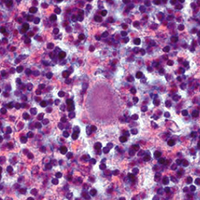Sporadic Creutzfeldt-Jakob disease: Real-Time Quaking Induced Conversion (RT-QuIC) assay represents a major diagnostic advance

Accepted: 7 September 2021
HTML: 24
All claims expressed in this article are solely those of the authors and do not necessarily represent those of their affiliated organizations, or those of the publisher, the editors and the reviewers. Any product that may be evaluated in this article or claim that may be made by its manufacturer is not guaranteed or endorsed by the publisher.
Authors
Sporadic Creutzfeldt-Jakob disease (sCJD) is a rare and fatal neurodegenerative disorder with an incidence of 1.5 to 2 cases per million population/year. The disease is caused by a proteinaceous infectious agent, named prion (or PrPSc), which arises from the conformational conversion of the cellular prion protein (PrPC). Once formed, PrPSc interacts with the normally folded PrPC coercing it to undergo similar structural rearrangement. The disease is highly heterogeneous from a clinical and neuropathological point of view. The origin of this variability lies in the aberrant structures acquired by PrPSc. At least six different sCJD phenotypes have been described and each of them is thought to be caused by a peculiar PrPSc strain. Definitive sCJD diagnosis requires brain analysis with the aim of identifying intracerebral accumulation of PrPSc which currently represents the only reliable biomarker of the disease. Clinical diagnosis of sCJD is very challenging and is based on the combination of several clinical, instrumental and laboratory tests representing surrogate disease biomarkers. Thanks to the advent of the ultrasensitive Real-Time Quaking-Induced Conversion (RT-QuIC) assay, PrPSc was found in several peripheral tissues of sCJD patients, sometimes even before the clinical onset of the disease. This discovery represents an important step forward for the clinical diagnosis of sCJD. In this manuscript, we present an overview of the current applications and future perspectives of RT-QuIC in the field of sCJD diagnosis.
How to Cite

This work is licensed under a Creative Commons Attribution-NonCommercial 4.0 International License.
PAGEPress has chosen to apply the Creative Commons Attribution NonCommercial 4.0 International License (CC BY-NC 4.0) to all manuscripts to be published.
Similar Articles
- H. Valpotić, A. Kovšca Janjatović, G. Lacković, F. Božić, V. Dobranić, D. Svoboda, I. Valpotić, M. Popović, Increased number of intestinal villous M cells in levamisole - pretreated weaned pigs experimentally infected with F4ac+ enterotoxigenic Escherichia coli strain , European Journal of Histochemistry: Vol. 54 No. 2 (2010)
- J. Rieger, P. Janczyk, H. Hünigen, J. Plendl, Enhancement of immunohistochemical detection of Salmonella in tissues of experimentally infected pigs , European Journal of Histochemistry: Vol. 59 No. 3 (2015)
- G Natale, G Lazzeri, C Blandizzi, M Ferrucci, M Del Tacca, Differential distribution of transforming growth factor-a immunohistochemistry within whole gastric mucosa in rats , European Journal of Histochemistry: Vol. 47 No. 4 (2003)
- Lisa Marie Wadephul, Kathrin Arndts, Gnatoulma Katawa, Eva Dietlmeier, William Horsnell, Achim Hoerauf, Manuel Ritter, Walking a thin line between fixation and epitope binding – characterization of antigen retrieval methods suitable for eosinophil and HSV-2 staining in formalin-fixed female reproductive tissue , European Journal of Histochemistry: Vol. 68 No. 2 (2024)
- CJ Woodall, DI Graham, Evidence for neuronal localisation of enteroviral sequences in motor neurone disease/amyotrophic lateral sclerosis by in situ hybridization , European Journal of Histochemistry: Vol. 48 No. 2 (2004)
- Matias Garrido, Camila Escobar, Constanza Zamora, Carolina Rejas, Juan Varas, Mario Párraga, Sebastián San Martin, Sandra Montedonico, Bile duct ligature in young rats: A revisited animal model for biliary atresia , European Journal of Histochemistry: Vol. 61 No. 3 (2017)
- C. Pellicciari, On the future contents of a small journal of histochemistry , European Journal of Histochemistry: Vol. 56 No. 4 (2012)
- J. Suchánková, S. Legartová, P. Sehnalová, S. Kozubek, S. Valente, D. Labella, A. Mai, C. Eckerich, F.O. Fackelmayer, D.V. Sorokin, E. Bartova, PRMT1 arginine methyltransferase accumulates in cytoplasmic bodies that respond to selective inhibition and DNA damage , European Journal of Histochemistry: Vol. 58 No. 2 (2014)
- S. Nemolato, P. Van Eyken, T. Cabras, F. Cau, M.U. Fanari, A. Locci, D. Fanni, C.L.P. Gerosa, I. Messana, M. Castagnola, G. Faa, Expression pattern of thymosin beta 4 in the adult human liver , European Journal of Histochemistry: Vol. 55 No. 3 (2011)
- Yingzhuo Guo, Hua Wang, Sodium hyaluronate promotes proliferation, autophagy, and migration of corneal epithelial cells by downregulating miR-18a in the course of corneal epithelial injury , European Journal of Histochemistry: Vol. 67 No. 2 (2023)
<< < 16 17 18 19 20 21 22 23 24 25 > >>
You may also start an advanced similarity search for this article.

 https://doi.org/10.4081/ejh.2021.3298
https://doi.org/10.4081/ejh.2021.3298










